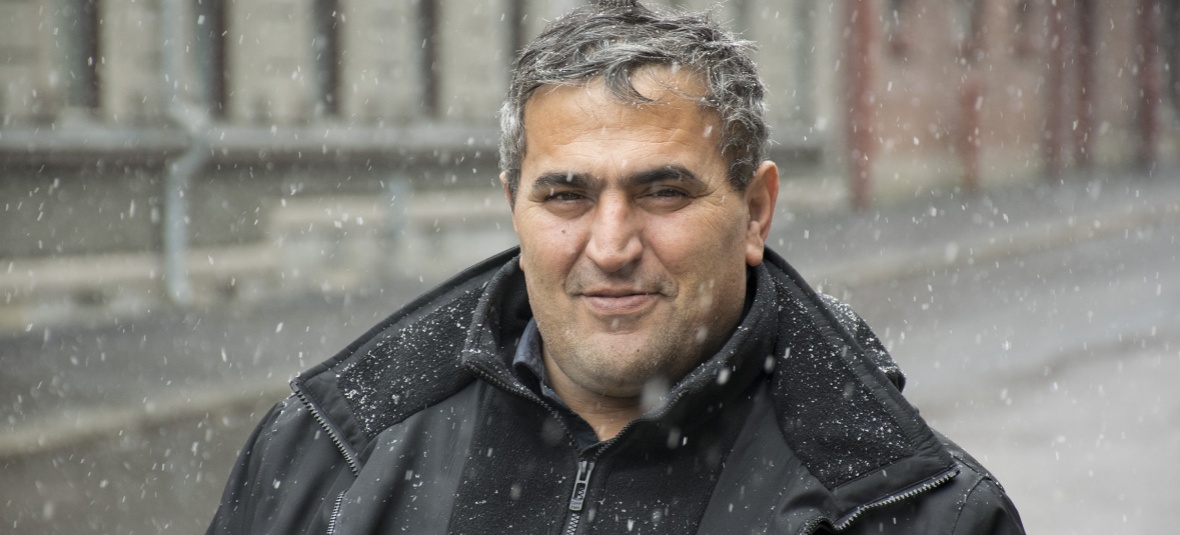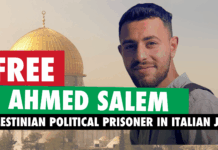The following article by Palestinian writer Khaled Barakat, coordinator of the Campaign to Free Ahmad Sa’adat, was originally published in Arabic in Al-Adab magazine on 2 November 2018. To read the original Arabic text, please visit the Al-Adab website.

When the positions of national forces clash in a country confronting occupation and colonization, as has been the case in Algeria, Ireland, India, South Africa and elsewhere, it is natural to inquire as to the motivations of this conflict and to identify those who benefit from the situation as well as those who are negatively affected.
The political and ideological struggle may progress toward armed internal war or civil confrontation, especially if the colonizer is not far away from the situation.
As we examine the contradictions between forces, we must also understand the role of “surrounding” forces that may appear outside the frame of the picture or who attempt to emerge in the role of “mediator.” In reality, these forces may be a cause of the conflict itself.
While a class-based analysis dominated the thinking of the left in general at one stage and at times became the only reference in addressing every issue (at times to the exclusion of relevant matters), unfortunately, in a later period, it has become almost or completely absent. This is particularly true in terms of the interpretation of contradictions on the Palestinian national political scene.
Therefore, it is necessary to paint a picture, even an incomplete and general one, of the conflicting Palestinian class interests, of which these intellectual and political contradictions reflect their public faces.
The dominant Palestinian minority
These are the interests and sectors that have dominated the ranks of the Palestinian leadership, including the leadership of the people and the revolutionary movement for the past century. For example, these sectors have dominated the Higher Arab Authority, the key leadership titles of the PLO, the Palestinian Authority and the Palestinian National Council. These interests have symbols and slogans that are subject to change at every stage. The leading Palestinian families may be the same, but their performance changes alongside changing modes of production, changing relationships with the foreign colonizer and reactionary systems of guardianship and authority and then with the Zionist occupation. However, in all cases they occupy the same central location.
This Palestinian minority has led us, after every stage, battle, revolt or uprising, into a major disaster. This occurred at the hands of the “Pasha” class, the remnants of Palestinian feudalism, the great landowners, merchants and “figures” who participated in aborting the 1936 revolution. The same happened in 1947 and later, to put an end to the great intifada of 1987-1993, and again from 2000-2005. As long as this minority, with abundant capital and power yet which does not exceed a few thousand individuals, continues to dominate over the Palestinian popular majority and to grasp the keys to the Palestinian political decision, our people will continue to suffer further disappointments and defeats.
Who forms this minority today?
It is difficult to identify one sector and call it the “class of the minority.” It has multiple roots, but it works in the service of the Zionist entity, the reactionary Arab regimes and imperialist forces, through a network of overlapping political and financial institutions, banks, corporations and economic projects. It has a government, prisons, ministries and embassies, particularly following the establishment of the Palestinian Authority in 1994.
This authority, which targets the armed resistance and cooperates with the Zionist enemy and foreign intelligence services, is a tool for both the Zionist occupation and this group, which we could call the Oslo class. It has a dual function – to consecrate the interests of the Palestinian minority and to protect the enemy in order for it to be “accepted” in its institutions, security and economic system. It continues to derive legitimacy from the Arab and international official recognition of it as the sole legitimate representative of the Palestinian people. And the Zionist entity responds to the needs of this class which is dependent upon it, strengthening its position within Palestinian society, and dealing with it as a junior follower or partner, giving it a share of the market in “Palestinian areas in Judea and Samaria.” This is formalized in the framework that has been officially labeled “economic peace.”
In other words, the class of the ruling Palestinian minority is a puppet of the occupation that consists of hundreds of big capitalists, their agents, business owners and subcontractors of projects with the occupation. The “Palestinian Authority” is a local administration for the projects of these large bourgeois interests.
Criticism of the positions of the PLO and Palestinian Authority leadership is, in essence, a critique of the dominant Palestinian interests that established the “wasta” system (“mediators” between the occupation and the masses), serving as a comprador class inside occupied Palestine. These sectors have tightened their control over the Palestinian political decision since 1974, when they seized control of the “revolution” and the Palestinian establishment, gradually moving toward the era of “Authority.” This transition has come about through the acceptance of the “self-rule” framework, through undemocratic and twisted machinations of the traditional Palestinian leaders and forces and through their largest political party, the Fateh movement.
Who is the Palestinian popular majority?
Since 1948, we have no longer been one coherent society living on our land, but many dispersed contingents, societies and communities inside and outside occupied Palestine, that have no bridges to connect them or meaningful economic, political and organizational connections.
The most prominent of these are the Palestinian refugee camps, numbering over 60. Some of these have been destroyed by continuous wars, Zionist and official Arab massacres at times and economic siege at other times. Their suffering continues daily with racist laws, negation of the refugees’ identity and ongoing resettlement projects. They are like “cantons” groaning under siege and poverty in the occupied homeland and in exile, and forming with the working classes and other marginalized sectors the popular Palestinian majority. These Palestinian belts of misery stretch from the Naqab to Jabalya, through Shatila, Baqaa and Yarmouk, to the faraway lands of migration, facing isolated struggles as if they are islands and filled with a sense of disappointment, anger and rage at the ongoing deceptions.
Who are they, and who are we?
So, we see two contradictory forces. While the Palestinian majority lives with isolation, marginalization and impoverishment, the minority strives for a fortune of $40 billion, lives a safe and protected life, lives in palaces, accumulates wealth, sends its children to prominent universities and institutions in the United States and Europe and pays no human price in the national liberation struggle, in comparison to the work and sacrifices of the masses.
As the class conflict intensifies between the dominant minority and the overwhelming majority, the minority attempts to resolve its own problems and its economic and political crises at the expense of the national rights of the majority: undermining the right of return; confiscating the rights of martyrs, prisoners and the wounded; plundering public property. This class attempts to deceive the majority politically, especially through the slogan of the so-called “independent Palestinian state,” which is, ultimately, the project of the Palestinian large bourgeoisie. However, this project is doomed to failure after its results have been made clear: the failure to prevent intensified settlement construction, the Judaization of Jerusalem, the imposition of the siege on Gaza and the continued denial of refugees’ return. The policies of the enemy, and even its bulldozers and aircraft, in some sense create a reality that destroys the icon of the “Palestinian state” created by this enemy itself.
The Palestinian popular majority has lost almost everything, including its natural position in the “revolution,” the PLO and the Palestinian national project, in favor of the large capitalist class that has taken control of everything. If the popular classes are those who have built the pillars of the revolution and the PLO, today, they find themselves cast to the side of the road. Yes, the struggling and working classes in occupied Palestine – workers, peasants, fishermen, lawyers, engineers, teachers, students, artisans and even the owners of small factories, workshops and projects – carried all the burdens of the revolution, the intifada and the armed struggle. They are the historic opponents of the Palestinian palaces and the Zionist entity. They are, especially in the camps, the primary stakeholders in the completion of their struggle: return and liberation.
This large popular Palestinian bloc that built the revolution is not looking for a fictitious “state.” It is fighting for the restoration of the land, the rights and the property that has been usurped. How can the popular classes, impoverished communities and marginalized groups be able to resume their role and reclaim the revolution that has been dispersed and degenerated?
Achieving this goal requires that this majority be aware of its historical role in the revolution and the movement for social change. This role can not only defeat the American-Zionist-reactionary liquidation project, but also defeat the project of the Palestinian minority of the imaginary “state,” instead moving toward a process of revolution and a movement for comprehensive change. This time, it must be led by the popular classes, for the first time in the history of the Palestinian national liberation struggle.
Phrases and slogans like “national reconciliation,” “ending the division,” “sole legitimate representative,” “Palestinian state,” “national project,” “independence,” “freedom,” “legitimacy,” “Jerusalem,” “popular resistance” and “the right to self-determination,” among others, have been exploited relentlessly. If put to the test today, you will find that each Palestinian party has its own definition of these concepts. The degradation of Palestinian political discourse in general and the use of deceptive language and concepts that are directed to justify the current political situation are constant policies of the ruling class, its intellectuals and its tools in the media.
Internal contradictions and the “peace process”
Nothing reveals the internal Palestinian contradiction more clearly and defines its parties more precisely than their positions on the “peace process.” This is because the conflict between the Oslo class and the Palestinian popular classes is revealed clearly in the stages of this deceptive project. For the Palestinian people, the “peace process” means a comprehensive liquidation of their cause, through colonization, ethnic cleansing, and the pacification of their movement; for the Palestinian financial class, it is a profitable process and a way of life!
A quarter of a century has passed since the signing of the Oslo accords, which constituted the major turning point in the Palestinian struggle for the occupation, imperialist powers and the large Palestinian bourgeoisie. It marks the beginning of the material transformation from the stage of the intifada/popular revolution to the phantom authority/pseudo-state. And on the shoulders of the Palestinian popular majority and the popular and armed resistance movement, rests the task of creating a revolutionary alternative that can confront the attempted liquidation of the Palestinian question and protect the unity of the people, the land and their rights.
Discover more from Samidoun: Palestinian Prisoner Solidarity Network
Subscribe to get the latest posts sent to your email.




